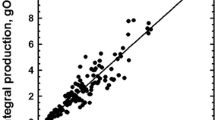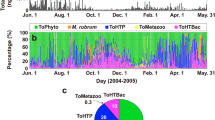Summary
Primary production measurements of benthic micro-algal vegetations were carried out with samples from six permanent plots. These permanent plots were assumed to cover the range of salinities and sediments in the estuary. A modification of the standard14C-procedure (COLIJN and VAN BUURT, 1975) was used throught this study. The sensitivity and reliability of the modified method, based on combustion of the filtered sediments and subsequent scintillation counting, is discussed. The method proves to be a fast one, and reliable with recoveries over 95%. Moreover, counting efficiences can be based on one quench curve only for all sediment samples. The method is also applicable for planktic primary production. To make a direct comparison of the six permanent plot possible, the potential primary production was measured under saturating light intensities. The incubation temperature corresponded with the temperature during sampling.
The results show a spring peak in both production and chlorophyll-a values on all permanent plots. Daily fixation rates were calculated, using daylength and tidal emersion data. No corrections for respiration during the dark period have been made. Production over 1975 was calculated, using 7 to 12 measurements per permanent plot. The results are given in Table I, which also shows the relative sediment composition and exposure time for the six permanent plots. The sediment composition is given as the mean extinction at 430 nm of a partly settled sediment suspension (SCHRÖDER, 1976).
Partial correlation coefficients of primary production with five variables (station, level, chlorophyll-a, salinity and temperature) were computed. Only chlorophyll-a showed a positive significant correlation coefficient (r=0.683; n=53). In contrast to the results of CADÉE and HEGEMAN (1974) in the western Wadden Sea no correlation could be found between primary production and temperature. The absence of a spring peak in the western part of the Wadden Sea is another striking difference with our results, for which no explanation can be given.
More measurements are needed over a longer period to model the benthic production of micro-algal vegetations. Such a model is needed to predict the primary production under changing environmental conditions.
Similar content being viewed by others
References
CADÉE, G.C. and J. HEGEMAN, 1974. Primary production of the benthic microflora living on tidal flats in the Dutch Wadden Sea. Neth. J. Sea Res., 8: 260–291.
COLIJN, F. and G. VAN BUURT, 1975. Influence of light and temperature on the photosynthetic rate of marine benthic diatoms. Mar. Biol., 31: 209–214.
SCHRÖDER, H.G.J. et al., 1976. Microbiologische inventarisatie van het Eems-Dollard estuarium. B.O.V.A., Eems-Dollard project, publicaties en verslagen 1976, 4, p. 1–133 (mimeographed report).
Author information
Authors and Affiliations
Rights and permissions
About this article
Cite this article
Colijn, F., Venekamp, L. Benthic primary production in the Ems-Dollard estuary during 1975. Hydrobiological Bulletin 11, 16–17 (1977). https://doi.org/10.1007/BF02282209
Issue Date:
DOI: https://doi.org/10.1007/BF02282209




